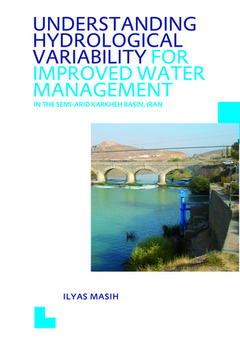Description
Understanding Hydrological Variability for Improved Water Management in the Semi-Arid Karkheh Basin, Iran
UNESCO-IHE PhD Thesis
Author: Masih Ilyas
Language: English
Subjects for Understanding Hydrological Variability for Improved...:
Keywords
Karkheh Basin; river; Karkheh River; flow; HBV Model; duration; NSE Value; curves; Paye Pole; processes; Swat; nash-sutcliffe; HBV; efficiency; Streamflow Trends; dam; River Basin Context; availability; Streamflow Simulations; streamflow; Swat Model; Case Ii; NAO Index; FDC; Daily Streamflow Records; 95PPU Band; Ungauged Catchments; NSE; Conceptual Rainfall Runoff Models; CV Value; Catchment Characteristics; Rain Gauge; Precipitation Input; Low Flow Months; Increase Soil Water Retention
Publication date: 10-2017
· 17.4x24.6 cm · Hardback
Publication date: 09-2011
180 p. · 17.4x24.6 cm · Paperback
Description
/li>Contents
/li>Readership
/li>Biography
/li>
This study provides a hydrology based assessment of (surface) water resources and its continuum of variability and change at different spatio-temporal scales in the semi-arid Karkheh Basin, Iran, where water is scarce, competition among users is high and massive water resources development is under way. The study reveals that the ongoing allocation planning is not sustainable and essentially requires reformulation, with consideration of spatio-temporal variability and observed trends in the streamflows regarding flood intensification and decline in low flows.
The development of innovative methods for quantification of the hydrological fluxes (i.e., regionalization of model parameters based on similarity of the flow duration curve and the use of areal precipitation input in the hydrological modeling) helped better understanding and modeling the basin hydrology. The investigation of scenarios for upgrading rain-fed areas to irrigated agriculture, using SWAT, recommends the promotion of in-situ soil and water conservation techniques. Conversion of rain-fed areas to irrigation causes significant reduction in the downstream flows, and requires additional considerations such as less development in the upper catchments, practicing supplementary irrigation and developing water storage. The knowledge generated is instructive for hydrological assessment and its use in water resources planning and management in the river basin context.




